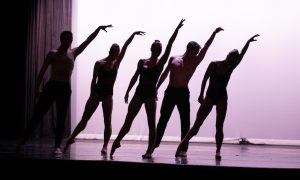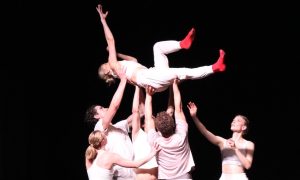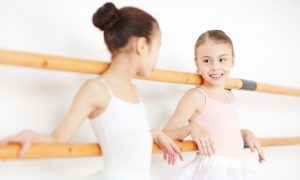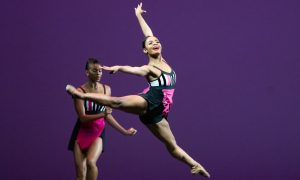Manhattan Movement & Arts Center
March 31 2012
By Leigh Schanfein.
When was the last time you went to a school dance performance? When was the last time you even had the inclination to do so? It may have been last week, it may have been a decade since, and chances are it was because you were related to one of the budding star performers. Of course we tend to associate school shows with baby ballerinas, simplistic choreography, and immature dancing, but we have to remember that not all dance schools put on the same show, especially in a locus like New York City. Perhaps we should not be so quick to dismiss amateurs when seeking a dance fix at the theater, and I can say this now because I have recently witnessed the unexpected. On March 31st the Manhattan Youth Ballet pulled off a great feat for any dance school; it put on a performance worthy of an audience that is comprised of more than family and friends.
The Manhattan Youth Ballet is a non-profit curriculum-based dance academy founded by Executive Artistic Director Rose Caiola, who is also a Broadway and film producer.The Ballet has a small but impressive faculty roster, including Head of Faculty Deborah Wingert, Choreographer-in-Residence Brian Reeder, and Artistic Advisor Daniel Ulbricht, the last of whom would also make a surprise appearance mid-show. The ballet’s Spring Performance opened with a new ballet by Reeder. Holding Court was a minimalist neo-classical piece that was far too dependent on a sense of irony that was completely lost on the youthful cast. The dancers looked beautiful in their vaguely baroque costumes, but there was better work to come. Le Jardin Anime, from the classic ballet Le Corsaire, was nicely done. Nicole Zadra did a particularly lovely job, looking very composed, soft, and elegant. The younger girls who made up the corps were very cute and not the least bit clumsy. What followed was a scene from another major ballet, Don Quixote, in a smartly staged series that notably included the delightful Liza Knapp-Fadani as a Kitri who pierced the stage with her flight and fire.
The second half of the show opened with an excerpt from George Balanchine’s A Midsummer Night’s Dream, that first struck me with the visual delight of colorful bug costumes that adorned the young cast. The shimmery fabrics were ingeniously twisted into wings and shells appropriate for the stage and cast, by a trio of costume designers who, as we were told in the opening remarks, are former professional dancers. After being thoroughly bowled over with the cute, I was doubly blown away by Daniel Ulbricht, appearing as King Oberon. He more than impressed me with his impeccable batterie, downy-soft landings, butter smooth turns, extremely smart use of space, and, oh yeah, his muscles. Ulbricht not only serves as Artistic Advisor to MYB, he also serves as a magnificent guest star and incredible model for the young cast. He was a fantastic surprise that momentarily carried my imagination to the majesty of Lincoln Center, and brought the level of the performance to that of the company with which he performs, New York City Ballet. Of course, my eyes and my mind had been seared. I was worried that I’d be unable to objectively review the remainder of the performance after Ulbricht magnificently manipulated my perspective. However, I continued to find the second part of the program to be a delight, my view perhaps prejudiced in favor of this talented group.
The second part continued with a series of variations: from La Fille Mal Gardee, which lacked confidence, Four Little Swans from Swan Lake, which required more teamwork and facial control, Raymonda, which had dramatic countenance but bumpy bourres, and August Bournonville’s Jockey Dance, which stood out as a winning performance. Both boys, Thomas Barnea and Julian Donahue, did a commendable job. The show closed with a short excerpt of Balanchine’s Stars and Stripes. The energetic corps looked great posing to Sousa, and soloist Savannah Green shone with strength. If only her smile were as unwavering as her pirouettes! I was left a bit disappointed that there was no solo variation, but the excerpt was a bright flash of color and enthusiasm that left a glow after the lights went down.
This pointe-predominant performance was entirely cringe-free, a feat for which I enthusiastically applaud MYB’s instructors. I find it strangely common to find dancers very weak en pointe in performance, even at a professional level. I’ve all too often held my breath, waiting for the imminent twisted ankle, precipitated by the “deer in the headlights” look in pre-professional, collegiate, and regional company performances. MYB should be proud of that. Even its youngest dancers look downright comfortable in pointe shoes. A problem remains, however, and it lays with the men. Usually, when there is a dearth of male dancers, those that are present carry a disproportionately large amount of the work. With MYB however, the four boys were a minimal presence, which was sad considering the budding talent these boys demonstrated.
If you seek cheap seats to see classical ballet and you are tired of the nosebleed section of the theater, you can easily satiate your craving with Manhattan Youth Ballet. With guest stars like Ulbricht, a smart program, and up-and-coming young dancers, you’ll be inspired to seek out the unattainable beauty of classical ballet.
For more information about Manhattan Youth Ballet, visit manhattanyouthballet.org
For more information about MYB’s home Manhattan Movement and Arts Center, which holds a limited selection of open classes and workshops, visit: manhattanmovement.com












